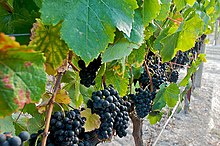Petit verdot
| Petit Verdot | |
|---|---|
| Grape (Vitis) | |

Petit Verdot
|
|
| Color of berry skin | Rouge |
| Species | Vitis vinifera |
| Also called | Verdot (more) |
| Origin | South West France |
| Notable regions | Bordeaux, Australia, Argentina, California, Virginia |
| Notable wines | Château Palmer |
Petit Verdot is a variety of red wine grape, principally used in classic Bordeaux blends. It ripens much later than the other varieties in Bordeaux, often too late, so it fell out of favour in its home region. When it does ripen it adds tannin, colour and flavour, in small amounts, to the blend. Petit verdot has attracted attention among winemakers in the New World, where it ripens more reliably and has been made into single varietal wine. It is also useful in 'stiffening' the mid palate of Cabernet Sauvignon blends.
When young its aromas have been likened to banana and pencil shavings. Strong tones of violet and leather develop as it matures.
Petit Verdot probably predates Cabernet Sauvignon in Bordeaux, but its origins are unclear. There are records of it in the eighteenth century, but its characteristics suggest an origin in much hotter climes than the Gironde.
It is one parent of Tressot, the other parent being Duras, a grape from the upper Tarn valley near Toulouse. It's possible that both were brought to the region by the Romans as they moved inland from the Mediterranean.
There are some blocks of Petit Verdot in Argentina, although for many years it was labelled as Fer.
Verdot was included in James Busby's collection of 1832, and it was trialled by Sir William Macarthur in the 1840s. In 2000 there were 1600 hectares in Australia with Kingston Estate in South Australia having the largest planting, four times more than in France. It is increasingly being used to make massive, brooding, single varietal wines that will age for several years - Pirramimma has championed this approach.
Chile had 137 ha in 2003.
Almost all the Petit Verdot in France is planted in Bordeaux, mostly in the Médoc where it is used in small amounts to give structure to the classic Bordeaux blend. However the late ripening means that in some years the entire crop is lost and it only properly ripens once every four years, so it has fallen out of favour, particularly with the trend towards earlier-maturing wine. Château Palmer is unusual in having up to 6% Petit Verdot in its blend, which helps stiffen the high proportion of Merlot in their wines. 1-3% is more usual.
...
Wikipedia
